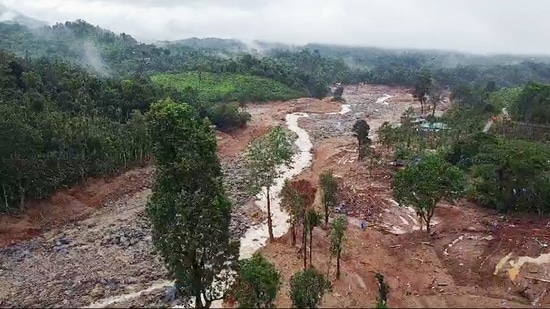Controversial tunnel road in Wayanad faces scrutiny after landslide tragedy
Environmental experts and residents fear the project could harm the ecologically sensitive Western Ghats and increase landslide risks.
While Kerala's northern hill district Wayanad is still reeling from its deadliest natural disaster, which devastated the Chooralmala-Mundakkai region, pressure is mounting on the Pinarayi Vijayan-led Left Democratic Front (LDF) government to halt a controversial ₹858 crore project for India’s third largest tunnel road. This project proposes drilling into the same mountains that house the landslide-struck, eco-sensitive villages, where the latest casualty figure is 342.

Also Read: Grieving headmaster mourns students lost in Wayanad landslide, says nature took them away
A favoured project of Vijayan, the 6.8 km tunnel claims to ease traffic between Kozhikode in Kerala and Mysore and Bangalore in Karnataka. However, it requires drilling into a critical portion of the ecologically sensitive Western Ghats. Despite the tragedy, the government remains silent on demands to reconsider the project.
The Konkan Railway Corporation Limited (KRCL) has been tasked with overseeing the construction and monitoring efforts for the project. Land acquisition is nearly complete on both sides of the tunnel. In Kozhikode district, 9.3 hectares out of the required 11.16 hectares have been acquired and transferred to the Public Works Department (PWD) as of June 6, with the remaining 1.85 hectares acquisition ongoing. In Wayanad, 8.32 hectares have already been handed over to the PWD.
Though the project’s environmental clearance is pending with the Union ministry of environment and climate change, state government sources claim the ministry is positive and an official confirmation is expected soon. Construction is scheduled to begin in September. To expedite the process, the state government has allocated ₹3.8 crore for the mandatory afforestation fund and secured an equivalent area of private land to mitigate the environmental impact. Additionally, ₹108 crore has been allocated to construct a vital 17.5-kilometre approach road from Thiruvambadi in Kozhikode district to Marippuzha, the proposed tunnel’s mouth. The total cost of the ₹2,149 crore project will be covered under the Kerala Infrastructure Investment Fund Board (KIIFB) scheme. The Uralungal Labour Contract Society, a well-known workers cooperative in Kerala, will handle the construction under KRCL’s supervision.
Also Read: Here's how you can donate to Kerala chief minister's relief fund for Wayanad landslides
Critics argue the state government has launched a massive, multi-crore project without conducting necessary financial feasibility, environmental impact, or sociological impact assessments. They highlight the risks of tunnelling in landslide-prone areas. Environmentalists fear the tunnel project might dispense hundreds of tonnes of rocks and damage the rich biodiversity of the sensitive region, including traditional elephant corridors.
“After halting the ambitious SilverLine semi-high-speed rail project due to environmental, social, and economic challenges, the Vijayan government is now pursuing this controversial multi-crore project without considering potential harm. Its proximity to the landslide-prone Wayanad region suggests trouble for the area, its people, and its biodiversity,” said Thiruvananthapuram-based environmental expert Sreedhar Radhakrishnan.
The tunnel road runs beneath Vavul Mala, the highest point in Kozhikode district at 7677 feet, part of the Chooraamala-Mundakkai hill ranges and one of the most ecologically sensitive areas of the Western Ghats. It borders Wayanad in Kerala and the Nilgiris in Tamil Nadu, home to several endemic species of flora and fauna. The region also receives the highest rainfall during the southwest monsoon.
Also Read: Wayanad tragedy | What is ‘dark tourism'? What does Kerala Police warning mean for tourists?
Chembra Peak, a prominent eco-tourism spot in Wayanad, is situated atop the proposed tunnel. Its summit hosts a heart-shaped lake within a Shola forest, a habitat for numerous rare bird species, including the critically endangered Banasura Laughingthrush or Banasura Chilappan. The Puthumala area between Chooralmala and Vavul Mala experienced a major landslide in August 2019, resulting in seven deaths and six missing persons, due to soil erosion causing soil piping.
Vijayan announced the two-lane subterranean tunnel road as a wider alternative to the congested Thamarassery Ghat road, promising to prioritise environmental and forest protection of the Western Ghats. However, N. Badusha, president of the environmental organization Wayanad Prakrithi Samrakshana Samithi, warns that the tunnel would terminate at Meppadi near Chooralmala, an area known for heavy monsoon rainfall. Both the Gadgil and Kasturirangan Committees have identified it as a highly sensitive region and a habitat for Asiatic elephants.
Badusha suspects the project’s approval might be influenced by mining barons interested in the granite and stones extracted during tunnel construction. V.S. Vijayan, an environmental scientist and expert member of the Madhav Gadgil Committee, believes the development lobby is a significant threat, aiming to exploit the state’s green cover. He stresses that tunnelling could devastate the rich biodiversity and disturb elephant corridors in the region.
Despite government assurances, many Wayanad residents doubt the project’s viability. Some suggest addressing Thamarassery Ghat Road’s traffic congestion by widening it and expanding the Vadakara-Kuttiyadi-Mananthavady road instead. K. Raveendran, a resident of Pozhuthana near Vythiri active in Wayanad’s hospitality industry, fears the tunnel project could exacerbate issues in a region prone to annual floods and landslides.
Supporters argue the tunnel will boost Wayanad’s development by reducing travel between Kalpetta and Kozhikode by 31 km. The existing road passes through a congested 13 km ghat section with nine hairpin bends on National Highway 212. The Chief Minister promised the tunnel’s completion within 34 months of commencement. However, concerns persist about assigning project implementation to KRLC, a company experienced only in building railway tunnels, and responsible for conducting the Environmental Impact Assessment (EIA) without the required accreditation and approval from the Quality Council of India.
Sreedhar alleges that entrusting the feasibility study to a company involved in construction represents a procedural lapse, undermining the EIA’s purpose. He emphasises the necessity of thorough studies to determine if construction would destabilise the mountain range’s structure, given the area's ancient rock formations and heavy rainfall.
Continue reading with HT Premium Subscription






